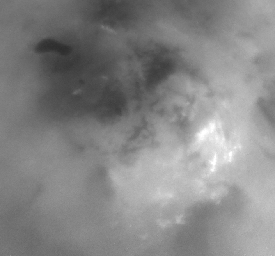Although it is far too cold for blossoming flowers, summer does bring storm clouds and presumably rain to Titan's south polar region. The observed persistence of convective storm activity in the region during the southern Titan summer has led scientists to speculate that the dark, footprint-shaped feature near the upper left could be a past or present reservoir for Titan's methane rains.
This series of three Cassini narrow-angle camera images, centered on the pole, shows the evolution of bright clouds in the region over the course of two hours during Cassini's distant June 6, 2005, flyby of the planet-sized moon.
The appearance of the feature seen here is unique among the dark terrains observed thus far on Titan. Other dark areas appear to have angular or diffuse boundaries, while this one possesses a smooth perimeter, suggestive of an eroded shoreline.
In addition to the notion that the dark feature is or was a lake filled with liquid hydrocarbons, scientists have speculated about other possibilities. For instance, it is plausible that the lake is simply a broad depression filled by dark, solid hydrocarbons falling from the atmosphere onto Titan's surface. In this case, the smoothed outline might be the result of a process unrelated to rainfall, such as a sinkhole or a volcanic caldera.
A still image of the south polar region from the same time period is also available (see PIA06240).
The images in this movie sequence were taken using a combination of spectral filters sensitive to wavelengths of polarized infrared light, allowing Cassini to see through the obscuring smog of Titan's atmosphere and down to the surface. The images were acquired from an approximate distance of 450,000 kilometers (279,000 miles) from Titan. Resolution in the original images is approximately 3 kilometers (2 miles) per pixel; the images were aligned and reprocessed at the same scale to create the movie.
The Cassini-Huygens mission is a cooperative project of NASA, the European Space Agency and the Italian Space Agency. The Jet Propulsion Laboratory, a division of the California Institute of Technology in Pasadena, manages the mission for NASA's Science Mission Directorate, Washington, D.C. The Cassini orbiter and its two onboard cameras were designed, developed and assembled at JPL. The imaging team is based at the Space Science Institute, Boulder, Colo.
For more information about the Cassini-Huygens mission visit http://saturn.jpl.nasa.gov. For additional images visit the Cassini imaging team homepage http://ciclops.org.

 Planetary Data System
Planetary Data System












